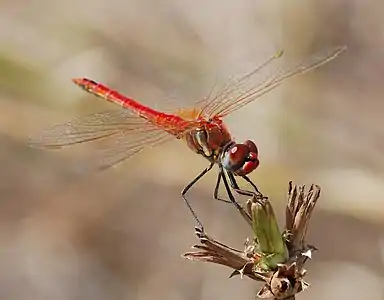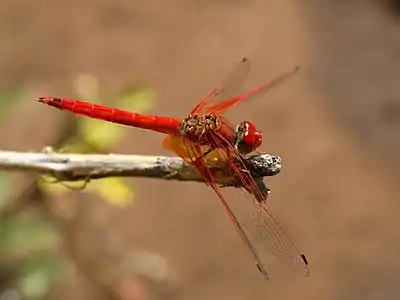Libellulidae
The skimmers or perchers and their relatives form the Libellulidae, the largest dragonfly family in the world. It is sometimes considered to contain the Corduliidae as the subfamily Corduliinae and the Macromiidae as the subfamily Macromiinae. Even if these are excluded (as Silsby does), there still remains a family of over 1000 species. With nearly worldwide distribution, these are almost certainly the most often seen of all dragonflies.
| Libellulidae | |
|---|---|
 | |
| Pantala flavescens | |
| Scientific classification | |
| Kingdom: | Animalia |
| Phylum: | Arthropoda |
| Class: | Insecta |
| Order: | Odonata |
| Infraorder: | Anisoptera |
| Superfamily: | Libelluloidea |
| Family: | Libellulidae Rambur, 1842[1] |
| Genera | |
|
see text | |
The genus Libellula is mostly New World, but also has one of the few endangered odonates from Japan: Libellula angelina. Many of the members of this genus are brightly colored or have banded wings. The related genus Plathemis includes the whitetails. The genus Celithemis contains several brightly marked species in the southern United States. Members of the genus Sympetrum are called darters (or meadowhawks in North America) and are found throughout most of the world, except Australia. Several Southern Hemisphere species in the genera Trithemis and Zenithoptera are especially beautiful. Other common genera include Tramea and Pantala.
The libellulids have stout-bodied larvae with the lower lip or labium developed into a mask over the lower part of the face.
Etymology
The family name may have been derived from the Latin libella which means "booklet".
Genera
The Libelluidae contain these genera:
- Acisoma Rambur, 1842 – pintails
- Aethiothemis Martin, 1908
- Aethriamanta Kirby, 1889
- Agrionoptera Brauer, 1864
- Amphithemis Selys, 1891
- Anatya Kirby, 1889
- Anectothemis Fraser, 1954
- Antidythemis Kirby, 1889
- Archaeophlebia Ris, 1909
- Argyrothemis Ris, 1911
- Atoconeura Karsch, 1899
- Atratothemis Wilson, 2005
- Austrothemis Ris, 1909
- Bironides Förster, 1903
- Boninthemis Asahina, 1952
- Brachydiplax Brauer, 1868
- Brachygonia Kirby, 1889
- Brachymesia Kirby, 1889 – tropical pennants
- Brachythemis Brauer, 1868
- Bradinopyga Kirby, 1893
- Brechmorhoga Kirby, 1894 – clubskimmers
- Calophlebia Selys, 1896
- Camacinia Kirby, 1889
- Cannaphila Kirby, 1889 – narrow-winged skimmers
- Celebophlebia Lieftinck, 1936
- Celebothemis Ris, 1909
- Celithemis Hagen, 1861 – pennants
- Chalcostephia Kirby, 1889
- Chalybeothemis Lieftinck, 1933
- Congothemis Fraser, 1953
- Cratilla Kirby, 1900
- Crocothemis Brauer, 1868 – skimmers
- Cyanothemis Ris, 1915
- Dasythemis Karsch, 1889
- Deielia Kirby, 1889
- Diastatops Rambur, 1842
- Diplacina Brauer, 1868
- Diplacodes Kirby, 1889 – perchers
- Dythemis Hagen, 1861 – setwings
- Edonis Needham, 1905
- Elasmothemis Westfall, 1988
- Eleuthemis Ris, 1910
- Elga Ris, 1911
- Epithemis Laidlaw, 1955
- Erythemis Hagen, 1861 – pondhawks
- Erythrodiplax Brauer, 1868 – dragonlets
- Fylgia Kirby, 1889 - white-eyed skimmer
- Garrisonia Peñalva & Costa, 2007
- Hadrothemis Karsch, 1891 – jungle-skimmers
- Hemistigma Kirby, 1889 – pied-spots
- Huonia Förster, 1903
- Hydrobasileus Kirby, 1889
- Hylaeothemis Ris, 1909
- Hypothemis Karsch, 1889
- Idiataphe Cowley, 1934 – metallic pennants
- Indothemis Ris, 1909
- Ladona Needham, 1897
- Lanthanusa Ris, 1909
- Lathrecista Kirby, 1889
- Leucorrhinia Brittinger, 1850 – whitefaces
- Libellula Linnaeus, 1758 (including Plathemis)
- Lokia Ris, 1919
- Lyriothemis Brauer, 1868
- Macrodiplax Brauer, 1868 – marl pennants
- Macrothemis Hagen, 1868 – sylphs
- Malgassophlebia Fraser, 1956
- Miathyria Kirby, 1889 – dashers
- Micrathyria Kirby, 1889 – tropical dashers
- Micromacromia Karsch, 1890
- Microtrigonia Förster, 1903
- Misagria Kirby, 1889
- Nannodiplax Brauer, 1868
- Nannophlebia Selys, 1878
- Nannophya Rambur, 1842
- Nannophyopsis Lieftinck, 1935
- Nannothemis Brauer, 1868 – skimmers
- Neodythemis Karsch, 1889
- Nephepeltia Kirby, 1889
- Nesciothemis Longfield, 1955
- Nesogonia Kirby, 1898
- Nesoxenia Kirby, 1889
- Neurothemis Brauer, 1867
- Nothodiplax Belle, 1984
- Notiothemis Ris, 1919 – forestwatchers
- Notolibellula Theischinger & Watson, 1977
- Oligoclada Karsch, 1890
- Olpogastra Karsch, 1895
- Onychothemis Brauer, 1868
- Orchithemis Brauer, 1878
- Orionothemis Fleck, Hamada & Carvalho, 2009
- Orthemis Hagen, 1861 – tropical king skimmers
- Orthetrum Newman, 1833
- Oxythemis Ris, 1909
- Pachydiplax Brauer, 1868 – blue dasher
- Pacificothemis Asahina, 1940
- Palaeothemis Fraser, 1923
- Palpopleura Rambur, 1842
- Paltothemis Karsch, 1890 – rock skimmers
- Pantala Hagen, 1861 – rainpool gliders
- Parazyxomma Pinhey, 1961
- Perithemis Hagen, 1861 – amberwings
- Phyllothemis Fraser, 1935
- Planiplax Muttkowski, 1910
- Plathemis Hagen, 1861
- Pornothemis Krüger, 1902
- Porpacithemis Fraser, 1954
- Porpax Karsch, 1896
- Potamarcha Karsch, 1890
- Protorthemis Kirby, 1889
- Pseudagrionoptera Ris, 1909
- Pseudoleon Kirby, 1889
- Pseudothemis Kirby, 1889
- Pseudotramea Fraser, 1920
- Raphismia Kirby, 1889
- Rhodopygia Kirby, 1889
- Rhodothemis Ris, 1909
- Rhyothemis Hagen, 1867
- Risiophlebia Cowley, 1934
- Scapanea Kirby, 1889
- Selysiothemis Ris, 1897
- Sleuthemis Fraser, 1951
- Sympetrum Newman, 1833 – meadowhawks, darters
- Tapeinothemis Lieftinck, 1950
- Tauriphila Kirby, 1889 – pasture gliders
- Tetrathemis Brauer, 1868
- Thalassothemis Ris, 1909
- Thermochoria Kirby, 1889
- Thermorthemis Kirby, 1889
- Tholymis Hagen, 1867 – evening skimmers
- Tramea Hagen, 1861 – saddlebags
- Trithemis Brauer, 1868 – dropwings
- Trithetrum Dijkstra & Pilgrim, 2007
- Tyriobapta Kirby, 1889
- Uracis Rambur, 1842
- Urothemis Brauer, 1868
- Viridithemis Fraser, 1960
- Ypirangathemis Santos, 1945
- Zenithoptera Selys, 1869
- Zygonoides Fraser, 1957
- Zygonychidium Lindley, 1970
- Zygonyx Hagen, 1867
- Zyxomma Rambur, 1842
Gallery
-_male_W_IMG_0512.jpg.webp)

_W_IMG_1681.jpg.webp)

 Sympetrum fonscolombii
Sympetrum fonscolombii.jpg.webp)
_-_Male.jpg.webp)



 Nymph of a Libellulidae
Nymph of a Libellulidae_male.JPG.webp) Diastatops pullata, male
Diastatops pullata, male_male.jpg.webp) Uracis fastigiata male
Uracis fastigiata male_male_Costa_Rica.jpg.webp) Uracis imbuta, male
Uracis imbuta, male_male.jpg.webp) Thermorthemis madagascariensis, male
Thermorthemis madagascariensis, male_male_2.jpg.webp) Thermorthemis madagascariensis, male
Thermorthemis madagascariensis, male_immature_male.jpg.webp) Thermorthemis madagascariensis, immature male
Thermorthemis madagascariensis, immature male
References
- Rambur, Jules (1842). Histoire naturelle des insectes. Névroptères (in French). Paris: Librairie Encyclopédique de Roret. pp. 534 [24] – via Gallica.
- Animal Diversity Web
- Martin Schorr; Martin Lindeboom; Dennis Paulson. "World Odonata List". University of Puget Sound. Retrieved 11 August 2010.
Bibliography
- Silsby, Jill. 2001. Dragonflies of the World. Smithsonian Institution Press, Washington D.C.
External links
 Data related to Libellulidae at Wikispecies
Data related to Libellulidae at Wikispecies Media related to Libellulidae at Wikimedia Commons
Media related to Libellulidae at Wikimedia Commons
